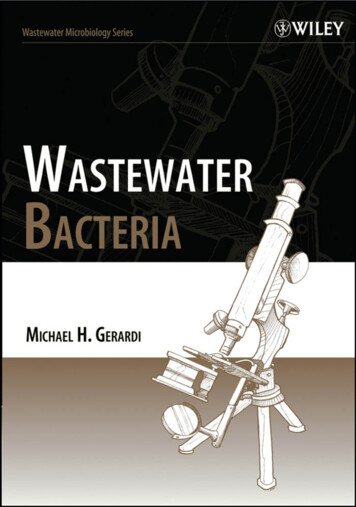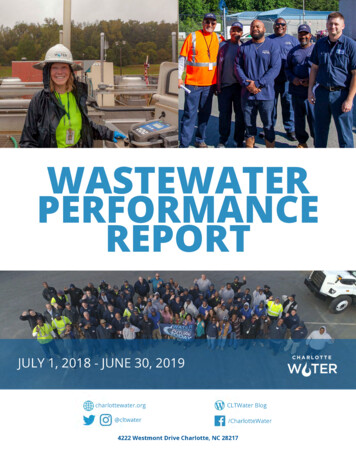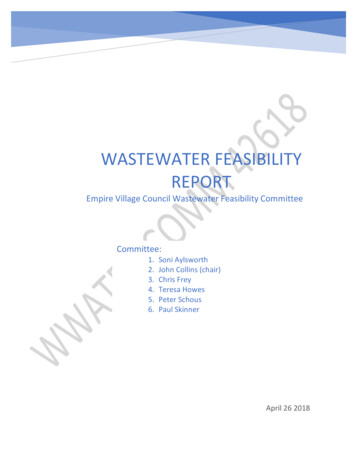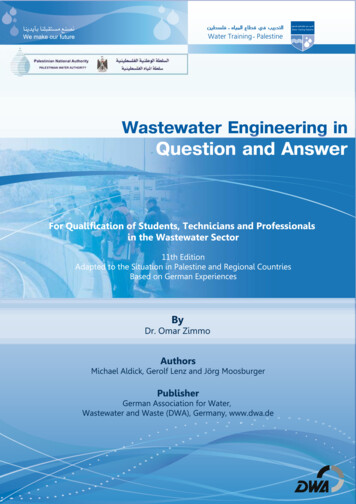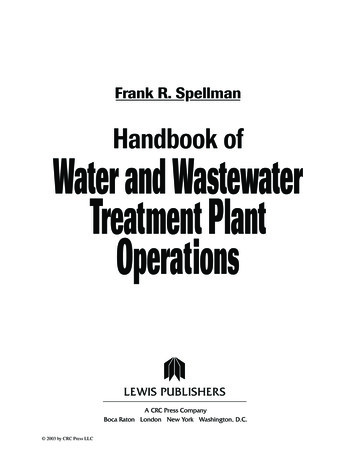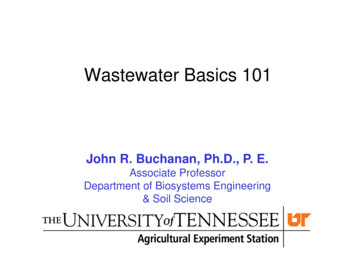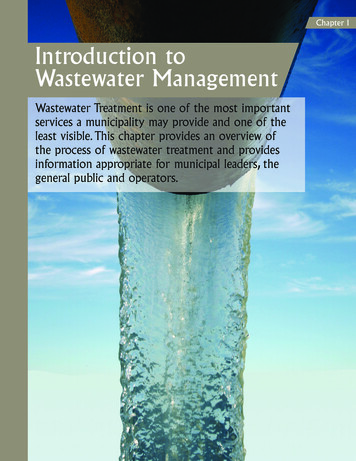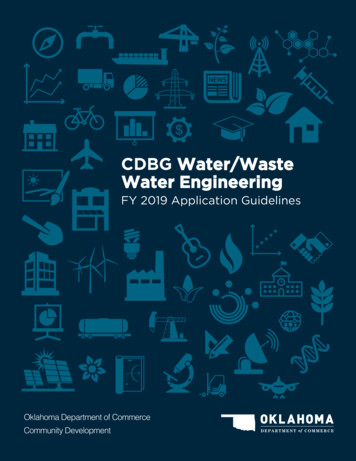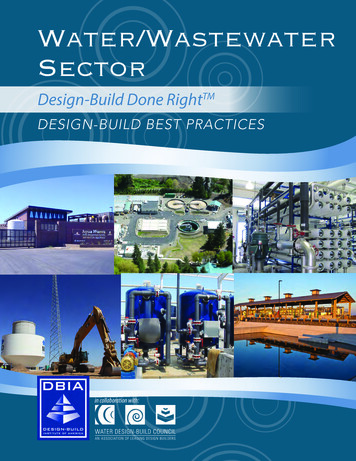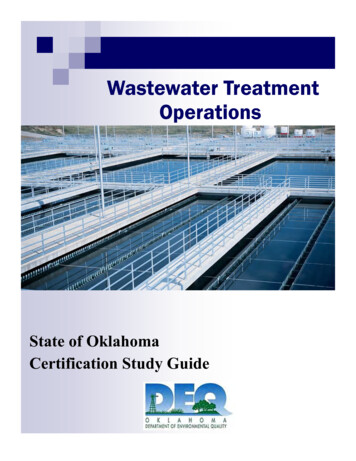
Transcription
Wastewater TreatmentOperationsState of OklahomaCertification Study Guide
This Study Guide is Dedicated to theCertified Wastewater System OperatorsOf the State of Oklahoma“Protectors of Public Health”For information concerning Oklahoma operator certificationrequirements or application procedures, please contactOklahoma Department of Environmental QualityOperator Certification SectionP.O. Box 1677, 707 N. RobinsonOklahoma City, OK 73101-1677(405) 702-8100
WASTEWATER CERTIFICATION STUDY GUIDE2ND EDITION 2017WASTEWATER CERTIFICATION STUDY GUIDE CREDITS AND ACKNOWLEDGEMENTSThis edition developed by Rose State College as requested byDEQ, under the direction of Chris Wisniewski Environmental Programs ManagerMajor Contributors2nd EditionAdvisor2nd EditionMajor Contributors1st EditionRobert KruegerFred RiceENVT, Adjunct Instructor Rose State CollegeENVT, Adjunct Instructor Rose State CollegeBill ClarkENVT, Coordinator Rose State CollegeDoug MathenyCarl GrayDana RundleJesse L. VaughnBill BagleyLaird HughesPatrick FrisbyKristi SangerThis publication contains copyrighted material from California State University, Sacramento’soperator training manuals. This material is reprinted by permission of the Hornet Foundation, Inc. ofCalifornia State University, Sacramento.This project was initiated using written raining materials previously develop by Patrick Frisby anddistributed by Oklahoma State University, Oklahoma City.Several illustrations were reprinted or adapted from Introduction to Water Sources andTransmission, by permission. Copyright 1979, American Water Works Association.Many of the “Suggested Study guidelines” and “Other Study Suggestions” were reprinted fromWastewater Collection and Treatment Study Guide for New Mexico Utility Operator Certification with thepermission of Haywood Martin, New Mexico State University, Dona Ana Branch Community College.Editors 2nd EditionKris ChavisNoelle MercantGretchen AndersonRose State CollegeRose State CollegeDepartment of Environmental Quality (DEQ)The following persons provided comprehensive project review for the 1 st edition.David FarringtonKenneth D. KerriJohn RamseyDana RundleMarilyn St. ClairHarold StephensDr. H.J. ThungJesse L. VaughnJames R. WickizerCarl GrayKristi SandersWe also want to thanks all those who were involved in reviewing the first edition of the DEQStudy Guide.This Wastewater System Operations Certification Study Guide (“Study Guide”) is not intended to be used as a manualfor technical information regarding system operation or maintenance or to change, supersede, or replace any statute,rule, regulation, standard or other legal requirement currently in effect or that may be in effect subsequent topublication of this guide. The purchase, use and/or study of this guide shall not be considered a guarantee that the userwill successfully complete the certification examination. Any mention or trade names or commercial products does notconstitute and endorsement of recommendation for use by the State of Oklahoma,
Table of ContentsIntroductionSECTION IChapter 1Chapter 2Chapter 3PAGEBasics of Wastewater TreatmentCharacteristics of WastewaterGeneral Regulations and Management1721Wastewater Collection SystemsMaintenanceOperator Safety314771Preliminary and Primary TreatmentSecondary TreatmentAdvanced Treatment and Water Reuse109121141Chapter 10Chapter 11Chapter 12Sludge Digestion and Solids HandlingWastewater Treatment PondsDisinfection147159171APPENDIX AAPPENDIX BAPPENDIX CIntroduction to Basic Operator MathCertification Exam Formula SheetsIntroduction to Basic Chemistry189214217SECTION IIChapter 4Chapter 5Chapter 6SECTION IIIChapter 7Chapter 8Chapter 9SECTION IVBasic Abbreviations & Basic Conversion FactorsAnswers to Sample Questions219220GLOSSARY221Suggested References for StudyReference SourcesSources of Additional Study MaterialAdditional Reference Sources243244246247
IntroductionThis study guide has been prepared for persons interested in obtaining or upgrading theirOklahoma wastewater system operator certification. The chapters in this guide offer informationdesigned to help with each level of certification. Class D is entry level, and Class A is the mostadvanced of the certifications.This guide is not intended to be a reference manual for technical information. Its purpose isto help guide operators in their studies of each of the major subject areas. Each chapter in thisguide covers a different subject. Suggested guidelines for each subject area are listed bycertification level at the beginning of each chapter. A brief discussion is then provided primarilyfor the benefit of entry level operators, followed by suggested references, other study suggestionsand sample questions. The study guide is used by both instructors and students of approvedoperator training classes.Components of Each Chapter in this Study GuideSuggested Study GuidelinesThe Suggested Study Guidelines describe knowledge that may be needed by operators ofcommunity wastewater systems. These suggestions are designed to help direct study but do NOTaddress every item of information that an operator may need to know when taking a certificationexam or when performing actual job duties. The guidelines are designed to be used as a “checklist”when studying for a certification exam to help ensure sufficient preparation. Operators preparingto take a Class C, B, or A level certification exam should follow the guidelines listed for theirexam as well as those listed for all lower levels of certification.Entry Level DiscussionThe Entry Level Discussion is offered only as an introduction to the chapter subject. It should beused as a starting point for all persons preparing to take an exam. The answer to all of the questionsthat may be on the Class D exam can be found within these readings. Persons studying for higherlevels of certification should concentrate most of their efforts on the Suggested References forStudy in each chapter. Please remember that the Entry Level Discussion should never be usedas a reference for actual system operating or maintenance.Suggested References for StudyThese are the primary references for questions found on Oklahoma operator certification exams.A complete listing of all the Suggested References for Study and a “Reference Source Sheet” canbe found at the back of this study guide. References listed in Italics are needed for certificationpurposes only if preparing to take a Class A exam. Although many reference manuals areworthwhile and helpful, most of the references listed are taken from the manuals prepared byCalifornia State University at Sacramento (CSUS) for the U.S. Environmental Protection Agency.
Other Study SuggestionsThese suggestions include individual exercises that will help the operator fully understand thematerial referenced in the Suggested Study Guidelines. Operators who can perform these variousexercises, in addition to studying all the suggested materials, should be well prepared for theirexam.Sample QuestionsThese are questions representing the approximate difficulty level and format of the questions foundon certification exams. The answers to the questions can be found within either the Entry LevelDiscussion or the Suggested References for Study for the chapter. Answers to the Sample Questionsare listed near the back of this guide. Additional practice questions can be found within many ofthe Suggested References for Study.How to Use this Study Guide to Prepare forState Certification ExamsClass D CertificationPreparation for the Class D exam should include the use of this guide for both personal study andduring attendance at an approved standard entry level class. Begin studying by familiarizingyourself with the entire study guide. Next, completely read the Entry Level Discussion offeredwithin each chapter. Finally, read the Suggested Study Guidelines for Class D operators listed atthe beginning of each chapter and read the Entry Level Discussion for the chapter again.All operators are encouraged to obtain and read additional study material whenever possible. Someof the Other Study Suggestions listed in each chapter may also be helpful. APPENDIX A includespractice problems and explanations that may help to refresh basic math skills.Other Levels of CertificationStudents preparing to take a Class C, B, or A level operations exam are strongly encouraged to usethe Suggested References for Study listed in each chapter. The higher the level of certificationbeing sought, the more important these references become. Although there are many excellentreference books available, the suggested references should be used whenever possible as these arethe primary references used to prepare state certification exams.It is recommended that persons preparing to take these certification exams utilize extensivepersonal study to become knowledgeable in all the items listed in the appropriate Suggested StudyGuidelines. Also recommended is attendance at training classes including an approved standardintermediate level and/or advanced level class shortly before taking the exam. APPENDIX Bshould be reviewed to become familiar with the math formulas that will be provided with thecertification exam. APPENDIX C is a starting point for those needing an introduction to chemistry.
Oklahoma Certification Exam QualificationsWater and Wastewater Works Operator Examination Applications are available online at the DEQwebsite from the DEQ Operator Certification Unit, and the County DEQ offices. Examinationsessions are offered throughout the State on a regular basis. The dates and locations of allexamination sessions as well as most approved training classes are published on theDEQ website www.deq.state.ok.us/.Properly completed and signed exam applications must be received by the OperatorCertification Unit at least three weeks before the exam is to be taken. An examination fee ischarged for each exam taken. Payment of the exam fee must be made by check, money order, orcredit card made payable to the Operator Certification Unit, and must be submitted with the examapplication.Minimum qualifications for operator certification exams are listed in the table below.MINIMUM QUALIFICATIONS FOR CERTIFICATION EXAMSCLASSESTRAINING ˡEXPERIENCE ²WATER/WASTEWATER OPERATORD OperatorC Operator16 hrs of DEQ approved training36 hrs of DEQ approved trainingNoneB Operator100 hrs of DEQ approved training or itsapproved equivalentA Operator200 hrs of approved training, including at least40 hrs of DEQ approved courses in advancedtreatment and managerial training or itsapproved equivalent33 years of waterworks or wastewater worksoperation including one year actual hands-onoperating experience5 years of waterworks or wastewater worksoperation including 2 years actual hands-onoperating experience(a) For water works or wastewater worksoperators, one year of waterworks or wastewaterworks operationOPERATORTechnician8 hrs of DEQ approved trainingNoneC Operator36 hrs of DEQ approved training1 year distribution collection operationsTraining credit will be granted only for courses or workshops listed as approved by the DEQ or for courses, workshops, oralternative activities which have been approved in writing by the DEQ in advance.1Experience that is used to meet the experience requirement for any class of certification may not be used to meet the educationor training requirements.23Approved equivalents are listed in 252:710-36
All approved training hours are cumulative. All certified operators should keep permanentrecords of all approved training they have received. Any requests for experience credit forcompletion of classes in higher education must be accompanied with an official transcript.Oklahoma Operator Certification Exam InformationAll certification examinations consist of 100 multiple-choice questions. Each question on the examis worth one point. At least 70% of the questions must be answered correctly in order to pass theexam. When you take your exam, you are given an exam booklet, and answer sheet, and scratchpaper. Most math formulas needed are provided in the exam booklet (see APPENDIX A andAPPENDIX B for more information). The only items you should bring into the exam session area calculator, two no. 2 pencils, and the approval notification for your exam.Each exam is divided into 12 subject areas or “areas of competency” which correspond with thechapters in this study guide. All levels of certification exams include questions from each area.However, because potential job duties will change as higher level certifications is achieved, thepriority and number of questions for each subject area will vary between certification levels. Thechart below shows the suggested emphasis or priority to use when studying for certification exams.AREA OF COMPETENCYStudy Guide ChapterSections I1. Basic of Wastewater Treatment2. Characteristics of Wastewater3. General Regulations and ManagementSection II4. Collection Systems5. Maintenance6. Operators SafetySection III7. Preliminary and Primary Treatment8. Secondary Treatment9. Advanced Treatment (Tertiary)Section IV10. Sludge Digestion and Solids Handling11. Wastewater Treatment Ponds12. DisinfectionSUGGESTED STUDY EMPHASISClass DClass CClass BClass umHighLowMedium
Immediately following your exam completion, you will receive a report of your results. Your examreport will specify the number of questions which were include for each category on the examtaken and the percentage that were answered correctly. Exam categories correspond directly to thechapters and/or sections in this study guide. Your exam report is designed to help direct yourfuture studies and professional development. For example, if you passed the exam but scoredonly 60% in the category of Operator Safety, you would be encouraged to review thecorresponding chapter (Chapter 6) in this study guide.If you did not pass your exam, you should carefully re-study all categories in which you scoredbelow 70%. You may also want to review all the chapters in this study guide and/or attendadditional training before retaking your exam. You must wait at least 30 days before retaking acertification exam unless additional approved training has been completed in the interim.
Chapter 1Basics of Wastewater TreatmentSuggested Study GuidelinesAll certification levelsBe prepared to answer questions concerning:The purpose of wastewater treatmentThe importance and role of the wastewater operatorThe definitions of each of the following termsaerobicanaerobiccommunity wastewater systemdigesterdisinfectionpreliminary treatmentfacultative pondinfluentinorganicstabilizeeffluentwater pollutionorganicsludgeprimary treatmentsecondary treatment tertiary treatmentwastewater collection systemNational Pollutant Discharge Elimination System (NPDES)Oklahoma Pollutant Discharge Elimination system (OPDES)The average domestic wastewater production per person per day.The common conversion factors used in wastewater systems and how to use them.How to perform area and volume calculations for cylindrical and rectangular basins.How to convert between different volume/time units.Figuring dose of chemicals commonly used, both lbs. and ppm or mg/L.The most commonly used metric system units in wastewater systems and their values.Basic chemistry terms.1
Entry Level DiscussionAll over America and the world, people want and deserve clean water, and this need creates anintense responsibility to ensure that wastes be disposed of in a manner that reduces pollution,prevents the spread of waterborne diseases, and keeps our rivers suitable for both wildlife andrecreational use. Therefore, it is the responsibility of the wastewater system operator to maintain,or exceed, current standards for wastewater treatment, to constantly learn more about his or herprofession, and to operate the systems in a cost effective and safe manner. All certifiedwastewater system operators are considered Public Health Professionals who have a veryimportant role in protecting the public health in their communities.The Municipal Sanitary Sewer Collection System (SSCS), and conveyance systems are anextensive, valuable, and complex part of the nation’s infrastructure. Distribution systems consistof pipelines, conduits, pumping stations, force mains, and all other facilities used to collectwastewater. The proper functioning of these wastewater and water systems are among the mostimportant factors responsible for the general level of good health in the United States. Mostmembers of the general public take a well-operated SSCS for granted, without being aware of itsdesign and technical workings. The public expects these systems to function effectively at areasonable cost.According to the Environmental Protection Agency (EPA), of the more than 19,000 collectionsystems, about 4,800 are satellite collection systems. There are also private satellite collectionsystems, which are associated with a wide range of entities such as trailer parks, residentialsubdivisions, apartment complexes, and commercial complexes such as shopping centers,industrial parks, college campuses, and military facilities. In addition, commercial complexes,homeowner associations, and other entities may retain ownership of collector sewers leading tothe municipal sanitary SSCS. In some situations, the municipality that owns the SSCS may notprovide treatment of wastewater, but only send its wastewater to the municipal entity fortreatment. Collection systems of this nature are also referred to as satellite systems.The EPA estimates that the more than 19,000 collection systems in the U.S. would have areplacement value of 1 trillion to 2 trillion dollars. Another source estimates that wastewatertreatment and collection systems represent about 10 to 15 percent of the total infrastructure valuein the U.S. The collection system of a single, large municipality can represent an investmentworth billions of dollars. Usually, the asset value of the collection system is not fully recognized,and the collection system operation and maintenance programs are given low priority comparedwith wastewater treatment needs and other municipal responsibilities.For example, the Federal Water Pollution Control Act Amendments of 1972 were passed byCongress to regulate and improve the quality of effluents discharge into the streams and rivers ofthis country. The contaminants identified by the EPA as harmful to human health are calledprimary contaminants. In order to protect public health, a primary contaminant must not exceed acertain specified level known as the Maximum Contaminant Level (MCL). If an MCL isexceeded, public notification is required. Such processes cost a lot of money, so it is common tosee both public and private ownership of the current infrastructure.A large number of public and private entities may own different pipes and other components ofthe entire municipal SSCS. The customers of a municipal SSCS typically retain ownership of2
building laterals and are responsible for their maintenance. However, municipalities can havediffering regulations pertaining to lateral ownership. These regulations should be revised on acase-by-case basis and incorporated into any management plan.Brief History of Collection System Regulatory ActivitiesThe EPA has been working for a number of years on enhancing existing regulations to reduce oreliminate the occurrence of sanitary sewer overflows (SSOs), and to preserve the substantialinvestment in infrastructure that collection systems represent. In 1995, the EPA convened anUrban Wet Weather Flows Advisory Committee and an SSO Subcommittee. Both theCommittee and the Subcommittee included municipal representatives, advocacy groups, states,and the EPA. The SSO Subcommittee examined the need for national consistency in permittingand enforcing effective sewer operation and maintenance principles, public notification of SSOswith potential health and environmental dangers, and other public policy issues.On May 29, 1999, President Clinton directed the EPA to “improve protection of public health atour nation’s beaches by developing, within one year, a strong national regulation to prevent theover 40,000 annual sanitary sewer overflows from contaminating our nation’s beaches andjeopardizing the health of our nation’s families. At a minimum, the program must raise thestandard for sewage treatment to adequately protect public health and to provide full informationto communities about water quality problems and associated health risks caused by sanitarysewer overflows.”Optimizing Operation, Maintenance, and Rehabilitation of Sanitary Sewer CollectionThe current performance of many collection systems is poor, and many systems have receivedminimal maintenance for many years. Many systems are maintained by a “public works”department charged with various functions, such as street, sidewalk, storm drain, and sometimeswater utility maintenance. However, many times people want the convenient function of thesefunctions without spending the money; as a result, the wastewater collection systems sufferbecause officials and the public like to spend the money where the public can most see theresults.Wastewater collection systems also suffer from a history of inadequate investment inmaintenance and repair. This problem is also due to simply being forgotten by both the publicand officials of the industry. Because the inner workings are primarily underground and hiddenfrom view, they are often forgotten about and are allowed to weaken, break, or block beforerepairs are made. This causes an “out-of-sight, out-of-mind” view of the wastewater collectionsystem, which poses an inherent problem.The lack of proper maintenance has resulted in deteriorated sewers with subsequent basementbackups, overflows, cave-ins, hydraulic overloads at treatment plants, and other safety, health,and environmental problems. As one of the most serious and environmentally threateningproblems, sanitary sewer overflows are a frequent cause of water quality violations and are athreat to public health and the environment. Beach closings, flooded basements, closed shellfishbeds, and overloaded treatment plants are some symptoms of collection systems with inadequatecapacity and improper management, operation, and maintenance.3
The poor performance of many sanitary sewer systems and the resulting potential health andenvironmental risks highlight the need to optimize operation and maintenance of these systems.Wastewater treatment is the “last line of defense” against water pollution.SUGGESTED REFERENCES FOR STUDYCalifornia State University, Sacramento – Operation of Wastewater Treatment Plants–Vol. 1Chapter 1The Treatment Plant OperatorChapter 2Why Treat Wastes?Chapter 3Wastewater Treatment FacilitiesAppendixHow to Solve Wastewater Treatment Plant Arithmetic ProblemsCalifornia State University, Sacramento – Operation and Maintenance of WastewaterCollection Systems–Vol. 1Chapter 1The Wastewater Collection System OperatorChapter 2Why Collection System operation and Maintenance?OTHER STUDY SUGGESTIONSDraw a simple diagram of a typical secondary wastewater treatment facility which includes:Collection systemPlant pretreatmentSecondary treatmentDisinfectionPrimary sedimentationSolids going to an anaerobic sludge digester followed by sludge drying bedsIdentify typical influent characteristics (see also Chapter 2) and determine where they areremoved in the process train that you have drawn.For a review of basic math skills, read and work the problems in the APPENDIX A PracticeMath section of this study guide.To help prepare for all exams, practice using the appropriate formula sheets found inAPPENDIX B in this study guide.4
SAMPLE QUESTIONSClass DThe Federal Water Pollution Control Act Amendments was passed in what year?A. 1968B. 1972C. 1974D. 1975Class CThe term "Public Health Professional" is used to describe.A. The superintendentB. The DEQ inspectorC. An OperatorClass BA high quality effluent from a treatment plant:A. is the only goal of a good operator.B. will mean that the public will always appreciate all that you do.C. means that the plant is being operated safely and exactly as it should be.D. may mean little to the public if the plant doesn’t appear clean and well maintained.Class AYour community has voted to issue a bond to finance a new or improved wastewater treatment plant. Theconsulting engineers have submitted their plans and specifications for the project. You as the supervisorof this plant should?A. participate in the ground floor planning and be present or available during the construction period butnever consider yourself an actual member of the team of experts in your community.B. participate in the ground floor planning and be present or available during the construction period tobecome familiar with the system and to offer advice to the consulting engineer.C. try to stay out of the way during planning and construction but make sure that you get a good set of thefinal plans to study when the plant is put on-line.D. advise the consulting engineer to not include any processes or treatment concepts that you and theother operators are not currently familiar with.5
Blank Page6
Chapter 2Characteristics of WastewaterSuggested Study GuidelinesBe prepared to answer questions concerning:Class DBe prepared to answer questions concerning:Physical, chemical, and microbiological characteristics of wastewater.The definitions of each of the following terms and their genicNeutralMicrobiologyTotal AlkalinityPhenolphthalein AlkalinityFecal ColiformPhosphorusNitrogenNutrientsTotal SolidsTotal Dissolved SolidsSettleable SolidsTotal Suspended SolidsNon-Settleable SolidsDissolved OxygenAerobic BacteriaFresh WastewaterColiformCarbon DioxideAnaerobic BacteriaChemical Oxygen Demand (COD)Facultative BacteriaBiochemical Oxygen Demand (BOD)Septic BacteriaThe proper units of measurement for each of the general characteristics of water.The most important factors in properly collecting wastewater samples.The two basic types of wastewater samples based on how they are collected.Class CBe prepared to answer questions concerning guidelines listed for Class D certification and:The chemical symbols for the various chemical constituents of wastewater.The differences in the characteristics of treated versus untreated domestic wastewater.The average concentration of BOD and solids in domestic wastewater.How temperature effects DO values.What gases are produced under septic conditions.What gases are produced under fresh conditions.The effects carbon dioxide has on pH levels.Be prepared to answer other questions that require additional personal study.7
Class B and Class ABe prepared to answer questions concerning guidelines listed for lower levels of certificationand:The different types of sampling and the proper way to sample for each parameter.How to evaluate a BOD worksheet, including when you can and cannot use the results.Which methods of chlorine residual measurement are acceptable.The names of different methods used to measure wastewater parameters.Be prepared to answer other question that require a combination of actual experience andadditional personal study.Entry Level Discussion:A good basic understanding of the characteristics of wastewater is essential to the understandingof why and how wastewater treatment is formed. Because wastewater contains many differentsubstances, it is characterized by its physical, chemical and biological aspects. These substancesare expanded by the 3 main sources; (1) homes, (2) industries, and (3) storm runoff andgroundwater that enters through inflow, infiltration (I & I), and exfiltration.pH Potential of Hydrogen:The pH is a measurement of how acidic or basic, (sometimes referred to as alkaline) the itembeing tested is. The pH scale is from 0.0 to 14.0. pH values less than 7.0 are progressively acidicwhile pH of greater than 7.0 are progressively basic, (also called caustic or alkaline). A pH ofexactly 7.0 is considered neutral. Each pH unit on the scale is very significant because itactually represents a ten-fold increase or decrease in how acidic or basic the water is. It is for thisreason that pH measurements are always reported in tenths of a pH unit instead of just “roundingoff” to the nearest whole number. pH measurements should never be averaged together. The mostcommon method used for pH measurement is pH meter using a hydrogen ion-sensitive electrode.Most living organisms live in a narrow pH range that is near neutral. If an effluent has a pH thatis higher or lower than that of the receiving water, the organisms in the receiving water may bekilled off. In addition, if the pH of the influent coming into a wastewater treatment plant changesrapidly and significantly, the plant treatment processes may be disrupted.8
As a chemical component of the wastewater, pH has direct influence on wastewater treatability— regardless of whether treatment is physical/chemical or biological. Because it is such a criticalcomponent of the makeup of the wastewater, it is therefore critically important to treatment.By chemically adjusting the pH, we can remove heavy metals and other toxic metals from water.In most runoff of wastewater, metal and other contaminants are dissolved and will not settle out.If we raise the pH, the amount of negative hydroxide ions, the positively charged metal ions willform bonds with the negatively charged hydroxide ions. This creates a dense, insoluble, metalparticle that can settle out of wastewater given time or be filtered out manually using a filterpress.At an acidic pH, the excess of positive hydrogen and metal ions have nothing to bond
This study guide has been prepared for persons interested in obtaining or upgrading their Oklahoma wastewater system operator certification. The chapters in this guide offer information designed to help with each level of certification. Class D is entry level
